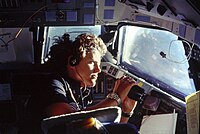Kathryn D. Sullivan
| Kathryn Sullivan | |
|---|---|

|
|
| Country: | United States |
| Organization: | NASA |
| selected on | January 16, 1978 (8th NASA Group) |
| Calls: | 3 space flights |
| Start of the first space flight: |
5th October 1984 |
| Landing of the last space flight: |
April 2, 1992 |
| Time in space: | 22d 4h 49m |
| EVA inserts: | 1 |
| EVA total duration: | 3h 29m |
| retired on | June 1993 |
| Space flights | |
Kathryn Dwyer "Kathy" Sullivan (born October 3, 1951 in Paterson , New Jersey , USA ) is a former American astronaut . During the space shuttle mission STS-41-G , on October 11, 1984, she was the second woman after Svetlana Savitskaya to go into space .
Life
Sullivan grew up in California and graduated from high school in Woodland Hills near Los Angeles in 1969 . She then studied geosciences at the University of California and spent a year as an exchange student in Norway, where she studied at the Geophysical Institute at the University of Bergen . In 1973 she obtained her bachelor's degree with distinction. Five years later, she received her PhD in geology from Dalhousie University , Halifax, Canada .
Astronaut activity
Sullivan was still working on her dissertation when she applied to the US space agency NASA as an astronaut and in the fall of 1977 visited the Johnson Space Center (JSC) for medical tests and discussions. In January 1978 she was presented with the eighth astronaut group as one of 35 new candidates. For the first time women were allowed to submit their application documents. Six were chosen to be mission specialists, and Sullivan was one of them.
She worked in various support teams for several shuttle missions, such as in software development, as a take-off and landing photographer, loading tests of the space shuttle, checkout and take-off support at the Kennedy Space Center , Florida and supporting EVAs. She was also a capsule communicator several times . As a mission specialist, Sullivan participated in three shuttle missions and spent 532 hours in space.
In October 1984, Sullivan undertook her first space flight as the STS-41-G's mission specialist . After the earth exploration satellite ERBS was launched, she carried out an outboard operation with David Leestma . The refueling of a satellite was simulated for the first time. The shuttle flight ended after eight days.
Sullivan's second flight began on April 24, 1990. The main task of STS-31 was to launch the Hubble Space Telescope , originally planned for August 1986 as the STS-61-J . After the Challenger disaster in January 1986 and the retirement of the nominated commander John Young , he was replaced by Loren Shriver and the launch of the telescope was postponed by four years. The Discovery landed on April 29th after five days.
STS-45 was Sullivan's last space flight. The ATLAS (Atmospheric Laboratory for Applications and Science) payload on board the Atlantis used a dozen instruments to investigate the composition of the earth's atmosphere in the spring of 1992. The Spacelab mission ended after nine days.
Activity according to NASA
In addition to her 15-year career as a NASA astronaut, Sullivan served as an oceanographic officer with the rank of captain in the US Navy reserves . Shortly before she left the US space agency, she was entrusted with the scientific management of the US weather and marine agency NOAA . After three years, in April 1996 she moved to the interactive science center COSI (Center Of Science and Industry) in Columbus (Ohio) as President and Chairman of the Board of Directors . Since December 2005 she has been a scientific advisor to the COSI. She was also appointed to the National Science Board in 2004, which oversees the work of the National Science Foundation . Since 2006 she has been vice chairman of the board. On February 28, 2013, she took over the management of NOAA, and was officially installed in this office on March 6, 2014 by the US Senate. In January 2017 she passed this position on to Benjamin Friedman.
Awards
Kathryn Sullivan received honorary doctorates from Kent State University (2002), Ohio Dominican University (1998), Stevens Institute of Technology (1992), State University of New York (1991) and Dalhousie University (1985). In 2016 she was elected to the National Academy of Engineering , in 2017 to the American Academy of Arts and Sciences .
Web links
- Short biography of Kathryn D. Sullivan at spacefacts.de
- NASA biography of Kathryn D. Sullivan (English; PDF)
- Biography of Kathryn D. Sullivan in the Encyclopedia Astronautica (English)
Individual evidence
- ^ NOAA: NOAA Leadership. Archived from the original on December 4, 2015 ; accessed on June 26, 2015 (English).
| personal data | |
|---|---|
| SURNAME | Sullivan, Kathryn D. |
| ALTERNATIVE NAMES | Sullivan, Kathryn Dwyer; Sullivan, Kathy (nickname) |
| BRIEF DESCRIPTION | American astronaut |
| DATE OF BIRTH | October 3, 1951 |
| PLACE OF BIRTH | Paterson , New Jersey, USA |